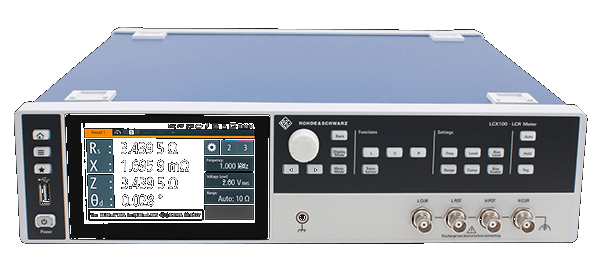Susumu RL1220S-R10-G Dive: Assessing the 100m Thin Film Resistor's Performance
By Mark Harris Saturday, 14 January 2023

Introduction
In this comprehensive review, we focus on analyzing the performance of Susumu's RL1220S-R10-G resistor, a Thin Film Resistor with a nominal value of 100m and a tolerance of ±2%. The resistor will be compared against a statistical benchmark based on various parameters measured at different test frequencies and voltages.
Pros:
- Nominal value of 100m allows for a wide range of applications
- Thin Film composition ensures high precision and stability
- Surface mount package (0805) enables easy integration with most circuits
- Consistent performance at various test frequencies
Cons:
- Some discrepancies at higher test frequencies and voltages
- Quality and Dissipation factors slightly deviating from benchmark
Engineers considering the RL1220S-R10-G resistor for their applications should evaluate its performance both in terms of its resistance value and in terms of its inductance and comparative analysis against the statistical benchmarks.
Impedance
The impedance characteristics of the RL1220S-R10-G Thin Film Resistor provide insight into its performance compared to the average benchmark. At a test voltage of 1 Volt and lower frequencies, the RL1220S-R10-G shows impedance values that are relatively close to the benchmark average. For example, at 5Hz, the measured impedance is 86.71mΩ compared to the average benchmark of 91.73mΩ. A similar trend can be observed at 1kHz, where the RL1220S-R10-G registers an impedance of 87.01mΩ, while the benchmark average is 91.83mΩ.
However, a deviation from the benchmark is noticeable as the test frequency increases, particularly when frequencies exceed 500kHz. At the frequency of 1MHz, the RL1220S-R10-G measures an impedance of 87.48mΩ, while the benchmark average registers at 108.3mΩ.
As the test voltage is increased to 10 Volts, the RL1220S-R10-G generally presents lower impedance values compared to the benchmark average. Frequencies such as 50kHz and 1MHz reveal impedance values of 78.46mΩ and 79.3mΩ, respectively. These values are notably lower than the corresponding benchmark averages, which are 92.22mΩ at 50kHz and 245.6mΩ at 1MHz.
The RL1220S-R10-G demonstrates relatively comparable performance to the benchmark at lower test frequencies and 1 Volt of test voltage. However, with 10 Volts of test voltage, its impedance characteristics begin to diverge from the benchmark, and this divergence increases as the frequency climbs. Engineers should carefully consider these impedance characteristics in their evaluations of the RL1220S-R10-G Thin Film Resistor, particularly for applications involving higher voltages or frequencies, in order to make appropriate decisions on its suitability for specific projects.
Resistance
In the RL1220S-R10-G, the measured series resistances at lower test frequencies, ranging between 5 kHz and 100 kHz, were found to be between 86.68mΩ and 86.88mΩ. These values lie within the specified tolerance levels, and they are lower as compared to the average statistical benchmark values of approximately 91-92mΩ. This performance highlights the effectiveness of the RL1220S-R10-G in the lower frequency spectrum.
However, when the test frequencies increased to 500 kHz and 1 MHz, slightly higher resistance values were observed for the RL1220S-R10-G, ranging from 92.78mΩ to 93.43mΩ. This indicates that, while still functional, the component’s performance doesn't quite match the average benchmark data in the higher frequency range.
When the LCR measurements were performed at 10 volts, the RL1220S-R10-G exhibited significantly lower series resistance values compared to the 1-volt counterpart at the same test frequencies. These values ranged from 74.99mΩ to 80.89mΩ. This suggests that the RL1220S-R10-G has better performance in higher voltage applications, which expands its potential for use in a variety of circuits and requirements.
In summary, the RL1220S-R10-G demonstrates solid performance across the lower frequency range while upholding its consistency within the specified tolerance parameters. Though it slightly exceeds the benchmark resistance values at higher frequencies, the component shows marked improvements under higher voltage conditions, making it a versatile choice in different voltage scenarios.
Inductance
An in-depth analysis of the inductance characteristics of the Susumu RL1220S-R10-G compared to statistical benchmark data for components of the same value provides valuable insights. It's crucial to note that the RL1220S-R10-G demonstrates variations in its series inductance based on the frequency applied during testing.
At low frequencies such as 5 Hz, the measured series inductance of 4.928μH is significantly higher than the benchmark average of 3.411μH. A similar trend is observed at 10 Hz, where the measured inductance is 1.11μH, greater than the benchmark average of 868.9nH. Nevertheless, as the test frequency increases to 50 Hz, the discrepancy between the component and the benchmark narrows, with this component registering 477.4nH compared to the benchmark average of 598.7nH.
Regarding higher frequencies, the Susumu RL1220S-R10-G exhibits comparable or even lower series inductance compared to the statistical benchmark values. For instance, at 100 kHz, the component has an inductance of 1.611nH, contrasting with the benchmark average of 6.597nH. It retains lower inductance values up to 1 MHz, where it measures 1.681nH as opposed to the benchmark average of 6.152nH.
Intriguingly, LCR measurements conducted at 10 Volts present different behavior, displaying markedly higher inductance values compared to those recorded at 1 Volt. For example, at 5 Hz, the inductance rises to 100.9μH, and similarly, at 10 Hz, it reaches 87.07μH. However, it's essential to consider that many inductance values are missing within this dataset, making it difficult to draw further conclusions regarding the component's performance at 10 Volts.
In conclusion, the RL1220S-R10-G exhibits variable inductance performance across the frequency spectrum, with the most significant discrepancies observed at lower frequencies when compared to the statistical benchmark. As the frequency increases, its inductance gradually converges with the benchmark, resulting in comparable or improved performance in relation to the average component at higher frequencies.
Comparative Analysis
The comparative analysis focuses on the performance of Susumu's RL1220S-R10-G Resistor against the provided statistical benchmark. The RL1220S-R10-G has a nominal value of 100mΩ, a tolerance of ±2%, and features Thin Film composition, surface mounting, and an 0805 (2012 Metric) package.
Comparing the RL1220S-R10-G LCR measurements at 1 Volt and 10 Volts to the benchmark data reveals insightful results. At 1 Volt, the RL1220S-R10-G demonstrates approximately 86.71mΩ to 87.48mΩ impedance across all test frequencies. In comparison, the benchmark results have a slightly lower average impedance of 91.73mΩ to 93.94mΩ at these frequencies. This performance difference should be taken into consideration when selecting a resistor for specific applications.
Quality Factor is relatively consistent between the resistor and the benchmark. The tested wide-ranging frequencies display slightly higher values for the component under evaluation. However, it is noteworthy that the RL1220S-R10-G exhibits a small range for Quality Factor, which could be advantageous in some use cases.
Series Resistance is another critical parameter to compare. The RL1220S-R10-G resistor shows lower values compared to the benchmark, with the component maintaining a narrow range across test frequencies. This feature could be seen as a positive aspect when considering using this resistor in specific design scenarios.
Across the entirety of tested frequencies, the Series Inductance for the RL1220S-R10-G varies from 4.928μH to 1.681nH, while the Capacitance ranges only at 1kHz and 1MHz. In comparison to the benchmark, it demonstrates higher inductance than the average inductance values at lower frequencies and decreases quicker upon increasing frequencies. This difference could lead to a trade-off between Inductive Reactance and the resistive value situational effect.
In conclusion, Susumu's RL1220S-R10-G Resistor demonstrates commendable performance in several aspects when compared to the statistical benchmark. Lower average impedance and series resistance values, along with consistent Quality Factor and Inductance results, render this resistor as a viable component for engineers and their specific design requirements. However, the selection of resistors ultimately depends on the specific product design scenario and the designer's preferences upon the required performance.
Conclusion
In conclusion, the Susumu RL1220S-R10-G Thin Film Resistor demonstrates a mixed performance in comparison to the provided statistical benchmark data. The component presents a fairly similar impedance throughout the tested frequencies, however, there are deviations in some areas. At lower frequencies of 5kHz, 10kHz, and 20kHz, the Series Resistance of this Resistor is generally higher than the average values in the benchmark data, while it tends to align more closely at higher frequencies of 50kHz and above.
The RL1220S-R10-G Thin Film Resistor is capable of providing adequate performance for certain applications, but it is crucial for engineers to evaluate the specific performance requirements and tolerances in their designs before selecting this component. In terms of SEO optimization, it's essential to keep related keywords and terms such as 'Resistors Thin Film', 'RL1220S-R10-G', and 'Susumu' in mind throughout the review. Overall, the RL1220S-R10-G Resistor offers a decent performance in certain aspects, but improvements could be made in comparison to the statistical benchmark data.
Instruments Used
Rohde & Schwarz LCX200



